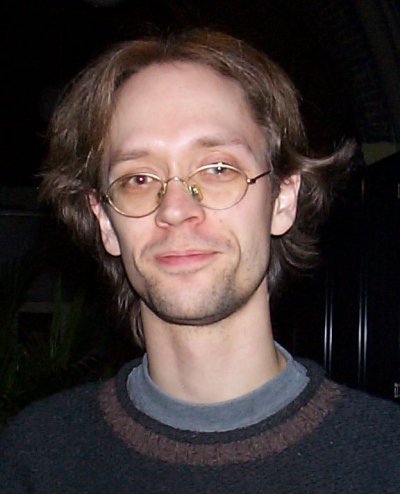 Dutch composer Samuel Vriezen was just here at Bard, supervising a rehearsal of his piece The Weather Riots, which my Open Instrumentation Ensemble is playing soon, and giving a wonderfully lively lecture about his compositional process. (He’s in New York for the riotous-looking Sequenza 21 concert happening this Monday at CUNY Graduate Center, where Weather Riots will also be performed, and which you can find out more about here.) Samuel usually writes pieces in which all the performers are playing similar material at the same time, unsynchronized. As we learned in rehearsal, it takes more virtuosity than you’d think from looking at the scores. His music has an interesting relationship to serialism (in the types of angular gestures he uses), to minimalism (since those gestures, all in 8th-notes, tend to get repeated and echo from instrument to instrument), and to the kind of experimental performance tradition of Cage, Earle Brown, and Christian Wolff.
Dutch composer Samuel Vriezen was just here at Bard, supervising a rehearsal of his piece The Weather Riots, which my Open Instrumentation Ensemble is playing soon, and giving a wonderfully lively lecture about his compositional process. (He’s in New York for the riotous-looking Sequenza 21 concert happening this Monday at CUNY Graduate Center, where Weather Riots will also be performed, and which you can find out more about here.) Samuel usually writes pieces in which all the performers are playing similar material at the same time, unsynchronized. As we learned in rehearsal, it takes more virtuosity than you’d think from looking at the scores. His music has an interesting relationship to serialism (in the types of angular gestures he uses), to minimalism (since those gestures, all in 8th-notes, tend to get repeated and echo from instrument to instrument), and to the kind of experimental performance tradition of Cage, Earle Brown, and Christian Wolff.
In the ’70s versions of such music, no one was much interested in controlling the results, and the pieces tended not to have a recognizable identity. Samuel, however, with his incisive mathematical mind, has figured out ways to base all his gestures on a finite number of formulas (a postminimal practice) in such a way that certain echoings among players are pretty much guaranteed to happen. That’s what’s so fun about rehearsing Weather Riots – you’re playing without regard to the rest of the ensemble, you’re even choosing your own route through the material, yet you invariably hear echoes of your own notes popping around elsewhere. He can even write multi-movement works like Panoramic Variations (scroll down) in which the movements, though based on identical techniques, are quite distinct from each other. My favorite piece of his so far is an epic two-piano work called 20 Worlds – a “world,’ in his terminology, being defined by a particular combination of gesture types. I gave up this kind of incompletely notated performance practice twenty years ago because the results seemed so hit-or-miss. He’s completely solved the problem: pieces whose details are different in every performance, but whose overall aura is remarkably consistent, recognizable, and quite lovely and lively. Brace yourself for a Vriezen onslaught on Postclassic Radio soon.
Samuel and I had a lot of great discussions too, and I learned some things. He says that, just as Schoenberg became an overwhelming influence in American musical academia in the ’60s and ’70s, the influence that flooded Dutch practice, and thus the composer whose exalted status young Dutch composers have most learned to resent, was Stravinsky. He also told a story about Cage I hadn’t heard. Cage’s 74, one of his late “number” pieces, is a ten-minute piece for 74-piece orchestra in which the bass instruments all read from one part, and the treble instruments from another. It seems that Cage received a fax one morning commissioning the work, wrote it in two hours, and faxed it back that afternoon. That’s the kind of compositional technique I’m looking for.
